Ryn Shell's Blog
October 9, 2025
Exploring Daylesford
The Charm of Miner's Cottages in Victoria's Spa Country
#wsite-video-container-477878883272782540{ background: url(//www.weebly.com/uploads/b/1987672-1488... } #video-iframe-477878883272782540{ background: url(//cdn2.editmysite.com/images/util/video... } #wsite-video-container-477878883272782540, #video-iframe-477878883272782540{ background-repeat: no-repeat; background-position:center; } @media only screen and (-webkit-min-device-pixel-ratio: 2), only screen and ( min-device-pixel-ratio: 2), only screen and ( min-resolution: 192dpi), only screen and ( min-resolution: 2dppx) { #video-iframe-477878883272782540{ background: url(//cdn2.editmysite.com/images/util/video... background-repeat: no-repeat; background-position:center; background-size: 70px 70px; } } This early witching hour found me driving through Daylesford, soaking in the charm of the minor cottages dotting the landscape. After admiring their character, I headed back to my Wren cottage to finish an ink pen and watercolor wash of one of those simple miner's cottages.
This early witching hour found me driving through Daylesford, soaking in the charm of the minor cottages dotting the landscape. After admiring their character, I headed back to my Wren cottage to finish an ink pen and watercolor wash of one of those simple miner's cottages.
Daylesford, nestled in Victoria's Central Highlands, is steeped in history as a gold rush town and later a spa resort. The buildings here reflect that rich past, with many significant structures dating back to the 1850s and 1860s. It’s fascinating to see how the gold mining era shaped this area, and how those quaint cottages tell the story of a time when hopeful prospectors flocked to the region, seeking their fortunes.
This piece is a fountain pen and ink sketch with watercolors by yours truly, Ryn Shell.
For my supporters, you can check out my website for art print gifts and tutorials. It’s a great way to dive deeper into the beauty of Daylesford and explore your own creativity!
[image error] [image error]
#wsite-video-container-477878883272782540{ background: url(//www.weebly.com/uploads/b/1987672-1488... } #video-iframe-477878883272782540{ background: url(//cdn2.editmysite.com/images/util/video... } #wsite-video-container-477878883272782540, #video-iframe-477878883272782540{ background-repeat: no-repeat; background-position:center; } @media only screen and (-webkit-min-device-pixel-ratio: 2), only screen and ( min-device-pixel-ratio: 2), only screen and ( min-resolution: 192dpi), only screen and ( min-resolution: 2dppx) { #video-iframe-477878883272782540{ background: url(//cdn2.editmysite.com/images/util/video... background-repeat: no-repeat; background-position:center; background-size: 70px 70px; } }
 This early witching hour found me driving through Daylesford, soaking in the charm of the minor cottages dotting the landscape. After admiring their character, I headed back to my Wren cottage to finish an ink pen and watercolor wash of one of those simple miner's cottages.
This early witching hour found me driving through Daylesford, soaking in the charm of the minor cottages dotting the landscape. After admiring their character, I headed back to my Wren cottage to finish an ink pen and watercolor wash of one of those simple miner's cottages.Daylesford, nestled in Victoria's Central Highlands, is steeped in history as a gold rush town and later a spa resort. The buildings here reflect that rich past, with many significant structures dating back to the 1850s and 1860s. It’s fascinating to see how the gold mining era shaped this area, and how those quaint cottages tell the story of a time when hopeful prospectors flocked to the region, seeking their fortunes.
This piece is a fountain pen and ink sketch with watercolors by yours truly, Ryn Shell.
For my supporters, you can check out my website for art print gifts and tutorials. It’s a great way to dive deeper into the beauty of Daylesford and explore your own creativity!
[image error] [image error]
Published on October 09, 2025 03:57
August 22, 2025
A Comprehensive Journey at Wren Cottage
 Introduction
IntroductionIt’s hard to believe that it has been 4.5 months since I made the big move from Shepparton to Daylesford. Relocating my life, along with my studio supplies and cherished garden favorites, came with its fair share of expenses. However, the joy of settling into my new home, Wren Cottage, has been worth every penny. Settling In
The transition was not just about moving; it was about creating a new life. The first challenge was setting up my new garden, which was already blessed with mature plants. I took it upon myself to plant over 500 assorted spring bulbs, and as the end of winter approaches, I’m thrilled to see them breaking through the ground.
In addition to the bulbs, I planted a variety of annual seeds in autumn. Initially, I was skeptical about their survival in the cold Daylesford winters, but to my delight, many are showing healthy growth! Unfortunately, the local rosellas had a feast on my freesias, but I have plenty of other plants to share with nature.
Orchid Collection
One of the most exciting aspects of my move has been my collection of several hundred seedlings of Dendrobium (Australian rock orchids) and Cymbidium orchids. I was concerned about their fate in this harsher climate, but with strategic placements in the gazebo and veranda—areas protected from frost but warmed by winter sunshine—they are thriving. These orchids were intended as a cash crop, but I’m just grateful they’re growing. I envision gifting many of them to my support team as a thank you for their help in settling me into Daylesford. Life at Wren Cottage
The reason for my move was to be closer to my husband, who is in aged care at Hepburn House. This Monday, we’ll celebrate his 85th birthday in his room. Visiting him can be tiring, with the need for considerable walking through the two-story building. However, I manage to maintain my beautiful little cottage and take daily walks with my Cavoodle, Tess.
Despite not being very active online lately, I still find time to write and publish short stories and novellas. My ink line and watercolor art diary projects continue to flourish, even as I adjust to my new surroundings.
Home Improvements Last month, I had my three-month cottage inspection by the real estate agency, which prompted me to invest in some decorating. The cottage boasts beautiful pitched timber ceilings with beams, but there’s no room for ceiling lights. Instead, I installed plant lights on timers and numerous standard lights throughout the space, creating a warm, inviting atmosphere.
I have also been fortunate to have a marvelous gardener assist me. Due to my physical disabilities, I can't manage heavy garden work, but with their help, I can look up from my computer and watch the Superb Fairy Wrens flit about outside my window. In the afternoons, I often catch sight of the larger, colorful rosellas and honey eaters feeding in the camellia blooming outside.
Personal Growth Financial recovery from the move is still a work in progress. This year has brought unexpected changes, including losing two dress sizes! While I needed the change, it was difficult to part with some of my favorite outfits. To make room for my new wardrobe, I repurposed my oversized clothes into nightwear. I treated myself to a new capsule wardrobe during the financial year sales, which included three jackets, five T-shirts, two skirts, and two pairs of pants.
Tess is also on my mind as her annual vet check-up approaches. I plan to give her a grooming session before spring arrives, which is just around the corner!
Future Plans
I eagerly anticipate the arrival of spring and hope to see more blossoming trees among the other plants in my garden. Although the azaleas and other established plants are recovering from last summer’s trials, I expect next year to bring a glorious display. I’m excited to see hydrangeas and agapanthus bloom in the summer, along with the beautiful scilla, or Spanish bluebells, emerging under the trees.
Living just a couple of kilometers from the stunning Lake Daylesford, I’m eager to venture out and explore the area. The charming former miner’s cottages and cottage gardens surrounded by Australian bushland make this place a painter's paradise. The wattles are beginning to bloom, and there’s so much beauty to capture on canvas.
Creative Endeavors In the realm of my artistic pursuits, I’ve transitioned 200 mixed media art tutorials and long-form videos to the tuition membership on my RynShell.com website. After facing challenges with YouTube monetization, I decided to implement a modest fee for access to my six years of tutorial videos. I’ll continue to share free short videos while aiming to provide more free-to-view content on my website.
As I work on completing these art tutorial pages by the end of August 2025, I look forward to resuming regular short video releases that will showcase my garden, studio, and the beautiful surroundings of Daylesford and Hepburn Shire.
Conclusion
Life at Wren Cottage is a journey filled with growth, both in my garden and personally. I’m excited about the future, with plans to explore my new surroundings, nurture my plants, and share my creative endeavors with you all. Stay tuned for more updates as I continue to embrace this beautiful chapter of my life!
Published on August 22, 2025 18:28
Step Back in Time: A Cozy Retreat at Laurel Cottage, Central Highlands, Victoria, Australia
Back in 2021, I took a mini-holiday, carer's respite at Laurel Cottage in historic Maldon, a quaint country town set in the Central Highlands of Victoria, Australia where you can still experience what life was like during the gold rush era, all be it with modern comforts.
I wondered past old weatherboard homes, solid stone buildings and decorative shop fronts in this lovingly preserved Australian gold mining town. In 2006, Maldon was awarded the 'most intact heritage streetscape' by the National Trust. Holiday at Laurel Cottage, Maldon, Central Highlands, Victoria, Australia. Laurel Cottage was built in the 1860s by Welshman John Lewis, who made his fortune on the goldfields. Cavoodle, Tessa, and I loved the rambling, old-world-style garden. We brunched at a Maldon cafe and went out for dinner at the Maldon Hotel, and also visited the Chocolate Mill and had picnic lunch at the Wombat Gardens in Daylesford. In the evening, we curled up in front of the wood fire.
The best of it was spending time with my youngest daughter and oldest granddaughter who I love. I came home so refreshed and eager to continue working at my writing and art for many more years.
I wondered past old weatherboard homes, solid stone buildings and decorative shop fronts in this lovingly preserved Australian gold mining town. In 2006, Maldon was awarded the 'most intact heritage streetscape' by the National Trust. Holiday at Laurel Cottage, Maldon, Central Highlands, Victoria, Australia. Laurel Cottage was built in the 1860s by Welshman John Lewis, who made his fortune on the goldfields. Cavoodle, Tessa, and I loved the rambling, old-world-style garden. We brunched at a Maldon cafe and went out for dinner at the Maldon Hotel, and also visited the Chocolate Mill and had picnic lunch at the Wombat Gardens in Daylesford. In the evening, we curled up in front of the wood fire.
The best of it was spending time with my youngest daughter and oldest granddaughter who I love. I came home so refreshed and eager to continue working at my writing and art for many more years.
Published on August 22, 2025 05:57
August 3, 2025
Sweet Peas in Soft Pastels
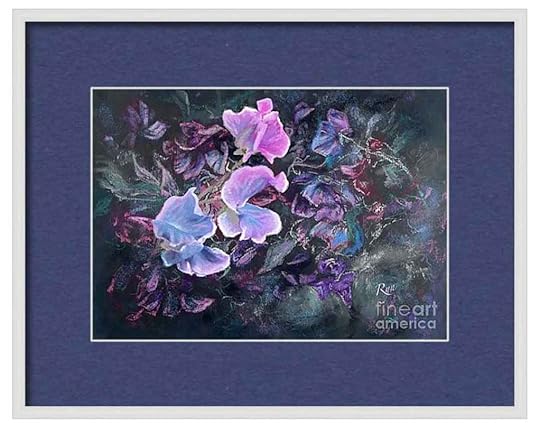 Bright Sweet Pea by Ryn Shell
Bright Sweet Pea by Ryn Shell 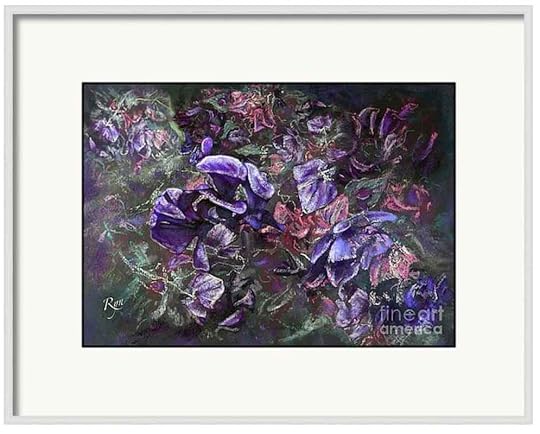 Sweet Peas in Pastels by Ryn Shell Coffee anyone? My arthritic hand is hurting from pushing pastels until I was satisfied, but the final result was worth it. I love the bright red and blue violet against the olive green colour harmony.
Sweet Peas in Pastels by Ryn Shell Coffee anyone? My arthritic hand is hurting from pushing pastels until I was satisfied, but the final result was worth it. I love the bright red and blue violet against the olive green colour harmony. 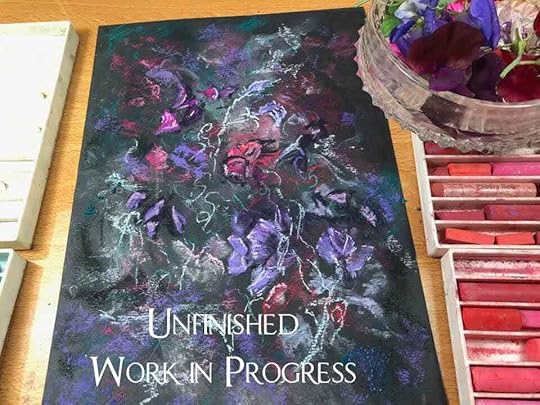
Published on August 03, 2025 07:00
How to Paint Sweet Peas in Soft Pastels
 Bright Sweet Pea by Ryn Shell
Bright Sweet Pea by Ryn Shell  Sweet Peas in Pastels by Ryn Shell Coffee anyone? My arthritic hand is hurting from pushing pastels until I was satisfied, but the final result was worth it. I love the bright red and blue violet against the olive green colour harmony.
Sweet Peas in Pastels by Ryn Shell Coffee anyone? My arthritic hand is hurting from pushing pastels until I was satisfied, but the final result was worth it. I love the bright red and blue violet against the olive green colour harmony. 
Published on August 03, 2025 07:00
My Fairy Wren visitors
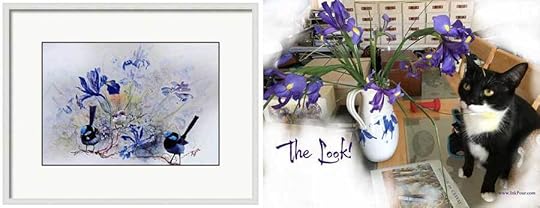
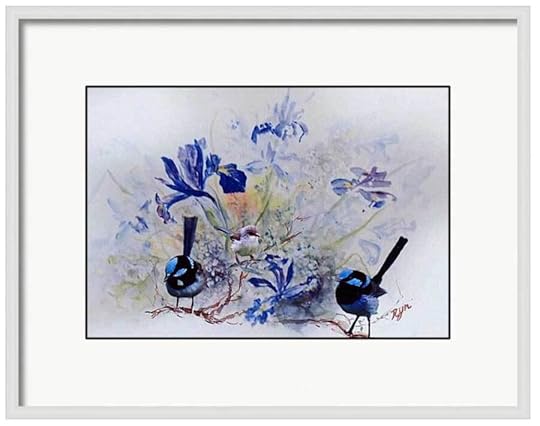 My latest work in progress.
My latest work in progress.  Health and Safety in the Arts: Ink
Health and Safety in the Arts: Ink 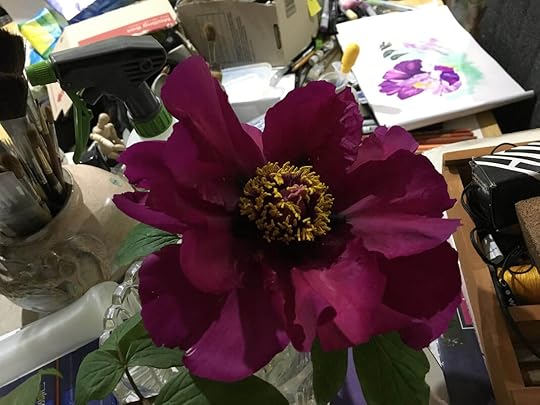 Former health and safety in the arts tutor nag coming up, and no apology for it if it saves someone's life.
Former health and safety in the arts tutor nag coming up, and no apology for it if it saves someone's life. Dye absorption through the skin is one of the reasons why those working in the industries that use dyes have a higher prevalence of bladder cancer than the general population. In those industries, the unions and the health inspectors ensure safe as possible handling.
Artists do not have health inspectors checking how they work, so they have a responsibility to themselves and their family to use best safety practices. You don't 'catch' cancer by getting dye on your skin today.
You cannot see the effects of gradual poisoning. The accumulative effect of getting dye on your skin will predispose you to get certain types of cancer, and that might take ten years to show up. You won't see the ill effects while you are playing in your art mediums.
Just don't deliberately put known poisons and carcinogens on your skin for the love of art, when you can so easily avoid doing so.
On this subject, I hope no one pours resins or acetone in the house with children breathing the air.
Don't make excuses.
Protect yourself from poison hazards.
If you get non food -safe dyes, pigments and art materials on your hands, and don't like wearing gloves—get over it!
The only way to master a new skill is to learn how and to practice it. I'll be sharing my tips freely, and I hope that makes up for my lack of experience in narrating and editing videos.
Let me help you develop art skills. Feel welcome to comment, and share with me what you are eager to learn.
Cheers, Ryn Shell.
Published on August 03, 2025 07:00
August 1, 2025
Painting the Northern Territory
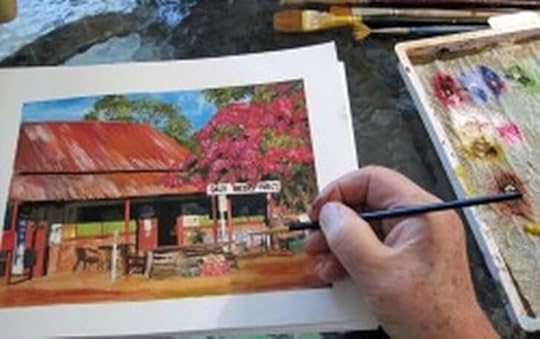 Daly Water's Pub Northern Territory.
Daly Water's Pub Northern Territory.The Daly Waters Pub, painted in flow formula acrylic, above image, by myself, artist Kathy Shell.
This pub is situated just off the main highway. It is a must visit for a barra and beef dinner with entertainment and a cheap overnight camp. There are clean showers, if you are happy to share with the cute frogs peeking out from behind the cistern to watch you.
The entertainment is fantastic.
The pub humour is topical, and about the location: If you stay more than one night, they say that they will make you the town mayor as the town's longest staying citizen.
Us gray gypsy travellers leave the suburbs for the peace of the bush and then wake everyone up before dawn with the screech or eek eek eek as we wind up the stabilizing feet on the caravan to be ready to roll out after breakfast, to rush to the next overnight campsite before dusk.
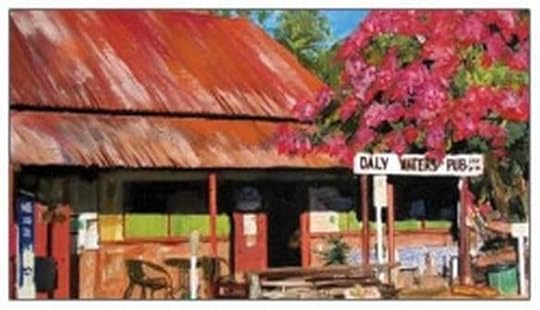 The Daly Waters' Pub is Hopping with Music and Frogs.
The Daly Waters' Pub is Hopping with Music and Frogs. Relax in a palm fringed thermal pool or hot springs.
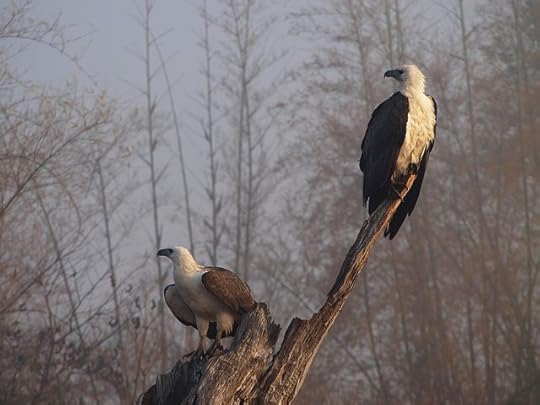
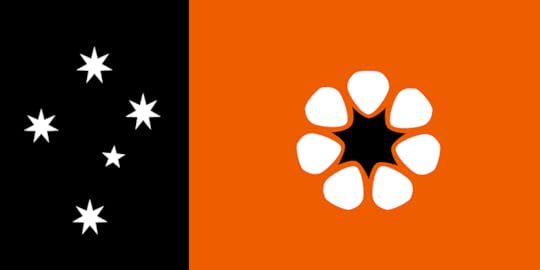 Northern Territory Flag
Northern Territory Flag 
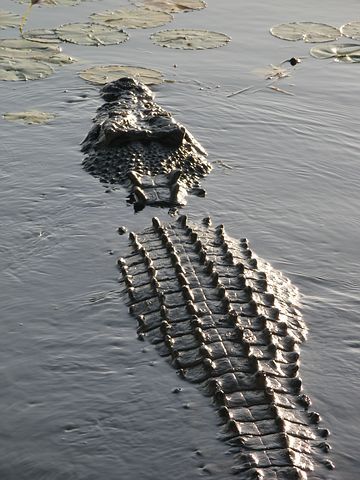
Saltwater crocodiles are now abundant in the waterways of Kakadu to the east and the Kimberly to the west of here and the Gulf country to the north.
The current policy in Katherine is to remove any saltwater crocodiles that migrate to this area so they can try to keep the waterways safe for locals and tourists.
The fishing with a hope of catching a barramundi from the Katherine river banks is popular, as is sitting around in groups in the pleasantly tepid water sharing travel stories, swimming and walking along the banks of this beautiful river.
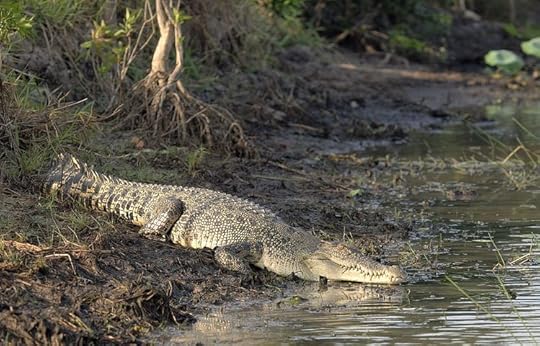
 The Northern Territory of Australia
The Northern Territory of Australia 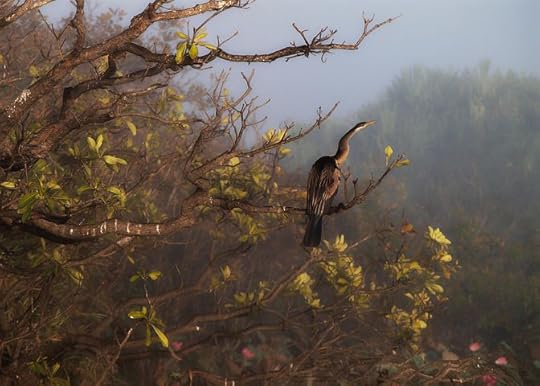
Published on August 01, 2025 07:00
Mooroopna Australia - Aussie Town on the Goulburn River.
Ryn Shell postcard fine art & story - Mooroopna Australia - Aussie town on the Goulburn River.
Aboriginal History Walk
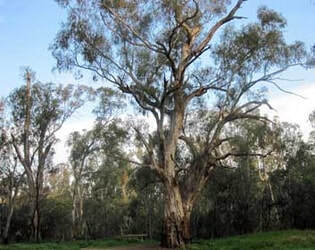
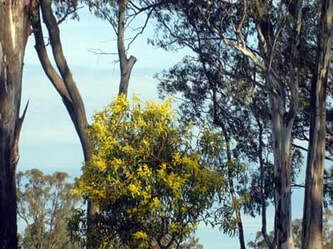
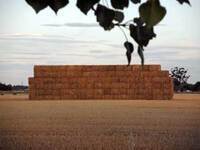 You begin the 4.3 km walk at Chinaman’s Garden Reserve. A well made and signposted History Walk teaches you the story of the Yorta Yorta Aboriginal community whose land you walk on. It shares the story of Cummeragunja ‘Walk Off’ that took place on 6 February 1939 and how the Yorta Yorta people returned to their river valley homelands, including this site, in Mooroopna, Victoria, Australia.
You begin the 4.3 km walk at Chinaman’s Garden Reserve. A well made and signposted History Walk teaches you the story of the Yorta Yorta Aboriginal community whose land you walk on. It shares the story of Cummeragunja ‘Walk Off’ that took place on 6 February 1939 and how the Yorta Yorta people returned to their river valley homelands, including this site, in Mooroopna, Victoria, Australia.
This is the Yorta Yorta people's long-standing traditional home. The Kaiela (Goulburn River) is their long association, home base.
By September 1946 there were 130 people aged from 8 days to 80 years living on the ‘riverside flats in 29 homes, mainly handy person constructed huts of tin or hessian bags and a few were tents.
The Yorta Yorta people were skilled hunter-gathers, surviving on crayfish, redfin, yellow belly and cod, from the Goulburn River and possums, turtles, turtle eggs, swan, duck, crane and other birds and their eggs.
It was usually the women who fished, and the men who hunted on the land.
When the river flooded, the families moved to Daish’s paddock, which was on higher ground, at the site now used by the KidsTown Adventure Playground.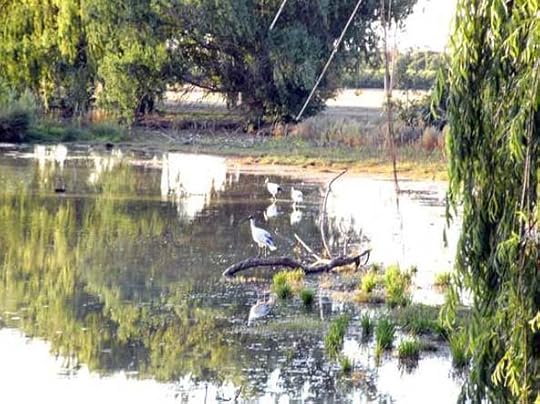
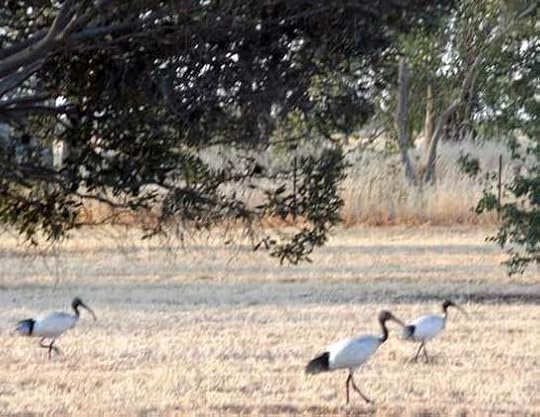
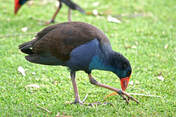 The story of the Cummeragunja ‘Walk Off’ is told on a sign at the flats.
The story of the Cummeragunja ‘Walk Off’ is told on a sign at the flats.
The Cummeragunja Walk-off at Barmah in1939 was the first ever mass strike of Aboriginal people. It was caused by long-standing neglect and increasingly restrictive controls on the movement and activities of the people, and the heartless removal of children from families. (stolen generations.)
Jack Patten, with the help of William Cooper, encouraged the people of the mission to leave. Some residents walking south to The Flats, while others settled closer, in the Echuca/Moama district.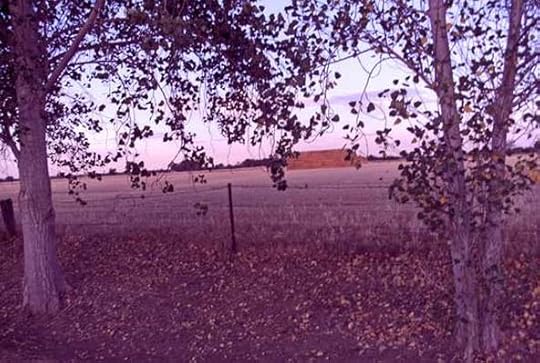
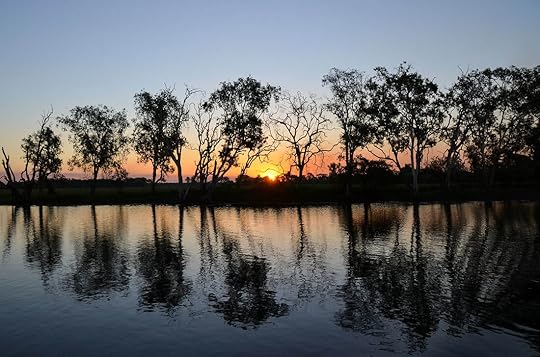 Jack Patten and William Cooper
Jack Patten and William Cooper
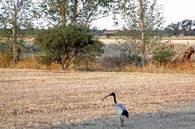 Both Jack Patten and William Cooper continued as spokesmen for the dispersed Aboriginal communities of Central Victoria and Western New South Wales. The action of these people helped bring about changes to the Aborigines Act of New South Wales.
Both Jack Patten and William Cooper continued as spokesmen for the dispersed Aboriginal communities of Central Victoria and Western New South Wales. The action of these people helped bring about changes to the Aborigines Act of New South Wales.
Jack Patten was sent to jail for encouraging the Aborigines to leave the Cummeragunja Reserve.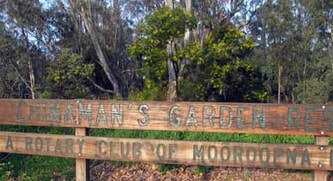
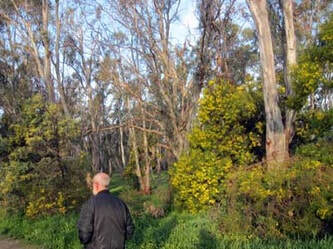 Mooroopna, Victoria, Australia, a rural Aussie example of community friendship.
Mooroopna, Victoria, Australia, a rural Aussie example of community friendship.
 Goulburn Riverside at Mooroopna, Yorta Yorta people self resettled following the Cummeragunja ‘Walk Off’. Mooroopna, with the aid of the example of the Yorta Yorta people and the multi-cultural community that established and maintained this area as the fruit bowl of Victoria, have influenced Mooroopna becoming a safe place for resettlement of refugees from Sudan. The Muslim community of the wider Shepparton, as well as Mooroopna district, have been a huge asset to the area. The local Mosque is as accepted as the Churches and Synagogue within our district. I am proud of and feel incredibly safe within our humanitarian Aussie country town.
Goulburn Riverside at Mooroopna, Yorta Yorta people self resettled following the Cummeragunja ‘Walk Off’. Mooroopna, with the aid of the example of the Yorta Yorta people and the multi-cultural community that established and maintained this area as the fruit bowl of Victoria, have influenced Mooroopna becoming a safe place for resettlement of refugees from Sudan. The Muslim community of the wider Shepparton, as well as Mooroopna district, have been a huge asset to the area. The local Mosque is as accepted as the Churches and Synagogue within our district. I am proud of and feel incredibly safe within our humanitarian Aussie country town. 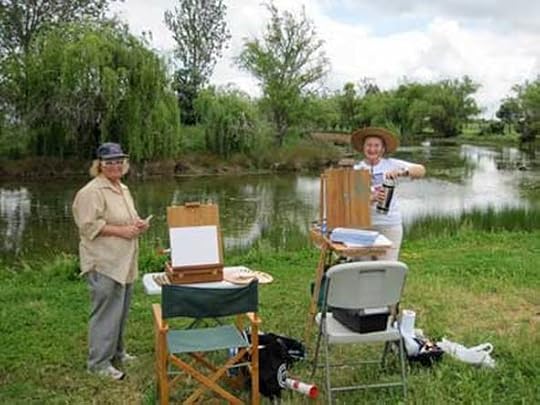
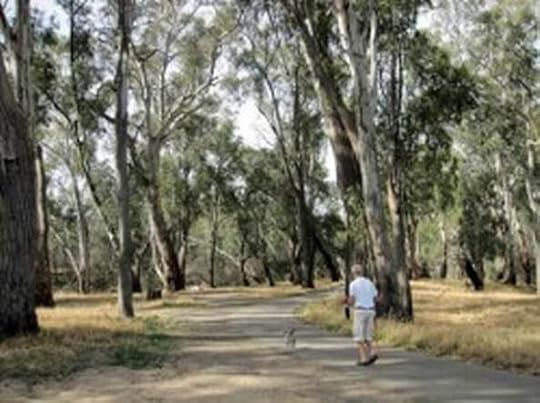 I am painting the Goulburn River using soft pastels in a time-lapse demonstration during this video art story. My art students have access to the longer, real-time painting demonstration videos and my art tutorials.
I am painting the Goulburn River using soft pastels in a time-lapse demonstration during this video art story. My art students have access to the longer, real-time painting demonstration videos and my art tutorials. 
 "The Flats" on the Goulburn River at Mooroopna following the Cummeragunja ‘Walk Off’,
"The Flats" on the Goulburn River at Mooroopna following the Cummeragunja ‘Walk Off’,
I live in the Goulburn Valley a walking distance from the area once populated and know as the flats. I love the are and the history of the families who lived there. Some people saw slums, I see proud independent families living close to nature. They were and are, wherever they and the following generation have gone to, good people. I dip my hat in respect to them.
I would love the hear the oral stories from the families of those who lived in The Flats.
Urban plan
Shepparton’s urbanisation was sufficiently extensive to attract the attention of the Slum Reclamation Board in 1936. It identified housing shortages.
The impact of World War II delayed a house building program, but in 1944 the Shepparton borough council commissioned a master plan for its future growth. The plan provided for a quadrupling of Shepparton’s population and of the municipality’s area, extensive surrounding parkland and visionary development of the urban areas.
Postwar soldier settlement occurred beyond Shepparton and the manufacturing and food processing infrastructure in the town was further developed, adding to population growth.
There were Housing Commission estates in 1946-55, in which over 1000 houses were built. In 1946 Shepparton was described in the Australian blue book:
For over 100 years immigrants from southern Europe have settled in the Shepparton area, and immigration to Shepparton was strong during the postwar years. In 1981 11.5% of Shepparton’s residents were born overseas, of whom nearly one third were born in Italy.
A Muslim mosque was opened in 1960.
The Aboriginal community established the Rumbalara village in 1958.
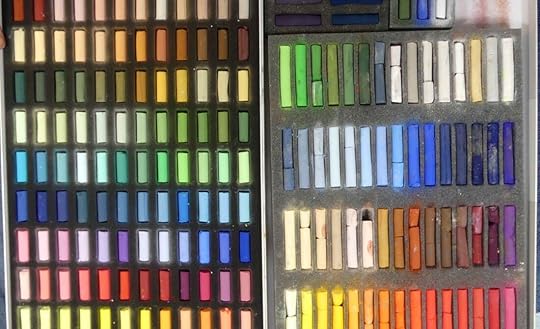
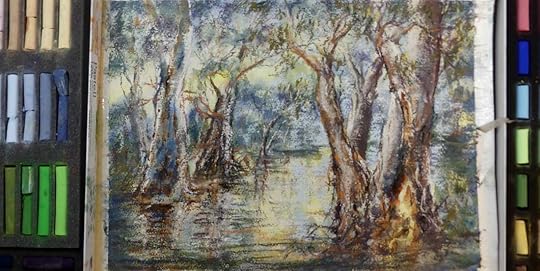 About the author and artist RYN SHELL.
About the author and artist RYN SHELL.
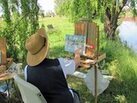 Ryn Shell, formerly of the Internationally acclaimed Buninyong Gallery captures the splendour of nature in art.
Ryn Shell, formerly of the Internationally acclaimed Buninyong Gallery captures the splendour of nature in art.
Ryn Shell is the winner of numerous prestigious professional awards from portraiture, landscape and still life-floral studies in the mediums of oils, watercolour, pastels, ink markers, drawing, plus pottery, sculpture, and literature.
Ryn Shell has taken fine art on tours around Australia, the US and in featured articles in the Australia Artist Magazine, and on Channel 9/WIN Television Network. She has represented Australia at the International Artists’ Festival.
Aboriginal History Walk


 You begin the 4.3 km walk at Chinaman’s Garden Reserve. A well made and signposted History Walk teaches you the story of the Yorta Yorta Aboriginal community whose land you walk on. It shares the story of Cummeragunja ‘Walk Off’ that took place on 6 February 1939 and how the Yorta Yorta people returned to their river valley homelands, including this site, in Mooroopna, Victoria, Australia.
You begin the 4.3 km walk at Chinaman’s Garden Reserve. A well made and signposted History Walk teaches you the story of the Yorta Yorta Aboriginal community whose land you walk on. It shares the story of Cummeragunja ‘Walk Off’ that took place on 6 February 1939 and how the Yorta Yorta people returned to their river valley homelands, including this site, in Mooroopna, Victoria, Australia. This is the Yorta Yorta people's long-standing traditional home. The Kaiela (Goulburn River) is their long association, home base.
By September 1946 there were 130 people aged from 8 days to 80 years living on the ‘riverside flats in 29 homes, mainly handy person constructed huts of tin or hessian bags and a few were tents.
The Yorta Yorta people were skilled hunter-gathers, surviving on crayfish, redfin, yellow belly and cod, from the Goulburn River and possums, turtles, turtle eggs, swan, duck, crane and other birds and their eggs.
It was usually the women who fished, and the men who hunted on the land.
When the river flooded, the families moved to Daish’s paddock, which was on higher ground, at the site now used by the KidsTown Adventure Playground.


 The story of the Cummeragunja ‘Walk Off’ is told on a sign at the flats.
The story of the Cummeragunja ‘Walk Off’ is told on a sign at the flats.The Cummeragunja Walk-off at Barmah in1939 was the first ever mass strike of Aboriginal people. It was caused by long-standing neglect and increasingly restrictive controls on the movement and activities of the people, and the heartless removal of children from families. (stolen generations.)
Jack Patten, with the help of William Cooper, encouraged the people of the mission to leave. Some residents walking south to The Flats, while others settled closer, in the Echuca/Moama district.

 Jack Patten and William Cooper
Jack Patten and William Cooper Both Jack Patten and William Cooper continued as spokesmen for the dispersed Aboriginal communities of Central Victoria and Western New South Wales. The action of these people helped bring about changes to the Aborigines Act of New South Wales.
Both Jack Patten and William Cooper continued as spokesmen for the dispersed Aboriginal communities of Central Victoria and Western New South Wales. The action of these people helped bring about changes to the Aborigines Act of New South Wales. Jack Patten was sent to jail for encouraging the Aborigines to leave the Cummeragunja Reserve.

 Mooroopna, Victoria, Australia, a rural Aussie example of community friendship.
Mooroopna, Victoria, Australia, a rural Aussie example of community friendship. Goulburn Riverside at Mooroopna, Yorta Yorta people self resettled following the Cummeragunja ‘Walk Off’. Mooroopna, with the aid of the example of the Yorta Yorta people and the multi-cultural community that established and maintained this area as the fruit bowl of Victoria, have influenced Mooroopna becoming a safe place for resettlement of refugees from Sudan. The Muslim community of the wider Shepparton, as well as Mooroopna district, have been a huge asset to the area. The local Mosque is as accepted as the Churches and Synagogue within our district. I am proud of and feel incredibly safe within our humanitarian Aussie country town.
Goulburn Riverside at Mooroopna, Yorta Yorta people self resettled following the Cummeragunja ‘Walk Off’. Mooroopna, with the aid of the example of the Yorta Yorta people and the multi-cultural community that established and maintained this area as the fruit bowl of Victoria, have influenced Mooroopna becoming a safe place for resettlement of refugees from Sudan. The Muslim community of the wider Shepparton, as well as Mooroopna district, have been a huge asset to the area. The local Mosque is as accepted as the Churches and Synagogue within our district. I am proud of and feel incredibly safe within our humanitarian Aussie country town. 
 I am painting the Goulburn River using soft pastels in a time-lapse demonstration during this video art story. My art students have access to the longer, real-time painting demonstration videos and my art tutorials.
I am painting the Goulburn River using soft pastels in a time-lapse demonstration during this video art story. My art students have access to the longer, real-time painting demonstration videos and my art tutorials. 
 "The Flats" on the Goulburn River at Mooroopna following the Cummeragunja ‘Walk Off’,
"The Flats" on the Goulburn River at Mooroopna following the Cummeragunja ‘Walk Off’, I live in the Goulburn Valley a walking distance from the area once populated and know as the flats. I love the are and the history of the families who lived there. Some people saw slums, I see proud independent families living close to nature. They were and are, wherever they and the following generation have gone to, good people. I dip my hat in respect to them.
I would love the hear the oral stories from the families of those who lived in The Flats.
Urban plan
Shepparton’s urbanisation was sufficiently extensive to attract the attention of the Slum Reclamation Board in 1936. It identified housing shortages.
The impact of World War II delayed a house building program, but in 1944 the Shepparton borough council commissioned a master plan for its future growth. The plan provided for a quadrupling of Shepparton’s population and of the municipality’s area, extensive surrounding parkland and visionary development of the urban areas.
Postwar soldier settlement occurred beyond Shepparton and the manufacturing and food processing infrastructure in the town was further developed, adding to population growth.
There were Housing Commission estates in 1946-55, in which over 1000 houses were built. In 1946 Shepparton was described in the Australian blue book:
For over 100 years immigrants from southern Europe have settled in the Shepparton area, and immigration to Shepparton was strong during the postwar years. In 1981 11.5% of Shepparton’s residents were born overseas, of whom nearly one third were born in Italy.
A Muslim mosque was opened in 1960.
The Aboriginal community established the Rumbalara village in 1958.

 About the author and artist RYN SHELL.
About the author and artist RYN SHELL. Ryn Shell, formerly of the Internationally acclaimed Buninyong Gallery captures the splendour of nature in art.
Ryn Shell, formerly of the Internationally acclaimed Buninyong Gallery captures the splendour of nature in art.Ryn Shell is the winner of numerous prestigious professional awards from portraiture, landscape and still life-floral studies in the mediums of oils, watercolour, pastels, ink markers, drawing, plus pottery, sculpture, and literature.
Ryn Shell has taken fine art on tours around Australia, the US and in featured articles in the Australia Artist Magazine, and on Channel 9/WIN Television Network. She has represented Australia at the International Artists’ Festival.
Published on August 01, 2025 07:00
Take Bucketts Way to the 'Tops.'
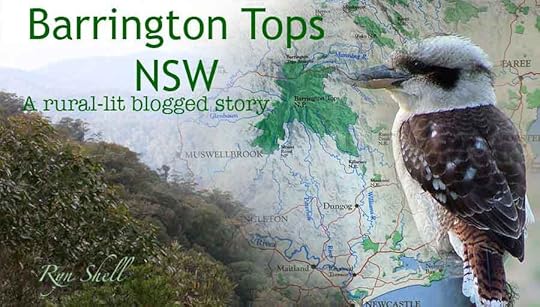 Leave the caravan at a coastal caravan park, park some light weight camping gear and take Bucketts Way through Gloucester for what is a steep, scenic drive up to the ‘Tops.’
Leave the caravan at a coastal caravan park, park some light weight camping gear and take Bucketts Way through Gloucester for what is a steep, scenic drive up to the ‘Tops.’This is a World Heritage Park covering 74,000 acres of bushland, with nature camping and well marked walking trails.
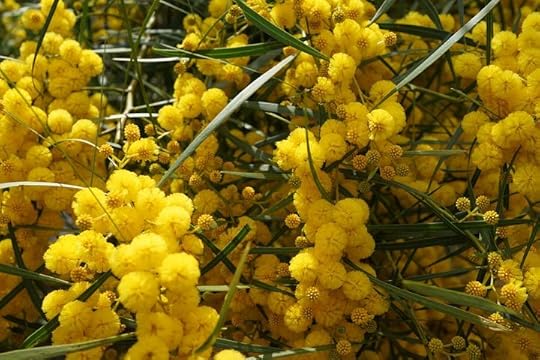
 This area is a feast for the eyes. Fauna and flora are abundant.
This area is a feast for the eyes. Fauna and flora are abundant. National Parks and Wildlife Service is a great website.
Try National Parks NSW for guidance for visitors to this area.
Nearby Manning Valley is a great place to stay if you want more overnight comforts than a tent.
"Ladies Well" can be found in the breathtaking Barrington Tops NSW.
It is an amazing place, and it has to be one of the most beautiful rain forest areas in Australia. When I visited in July 2013 there was free camping here. It's the journey that matters, not the destination.
There was plenty of fresh water and unspoiled countryside when Visited "The Tops." This was a free camping ground in 2013. Check with the National Parks services for current fees. Back then, there were some bins and a drop toilet. The old fashioned 'drop box.' hole in the ground with a seat over it. I'd be happy to pay a camping fee for improved toilet facilities. But, what a beautiful environment to camp. You will discover "Boot Hill" along the way. This is hundreds of thongs, boots, sandals, water shoes, joggers, pairs, singles, you name it, tied to a fence. Your car will get filthy, the road curves will try you, and you will reach Ladies Well via Allyn River Road.
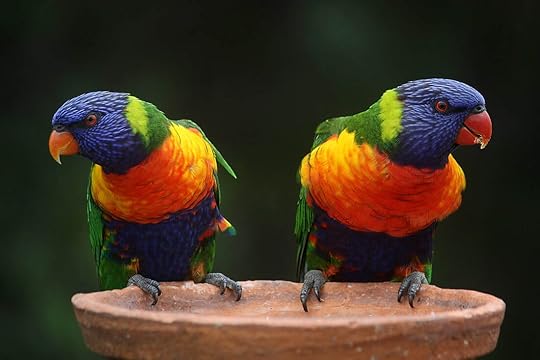 Every city needs a quiet haven, and Newcastle has the Barrington Tops only two hours away.
Every city needs a quiet haven, and Newcastle has the Barrington Tops only two hours away. 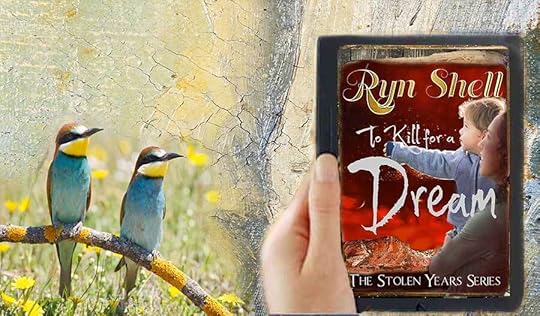 Ryn Shell's Australian rural-lit writing is enhanced by personal experience of nature and days spent with family in the Australian bushland. “Sure, Emily,” Iain said. “In the past, the Woggan-Wandong never camped near water. We believe the Dreaming Spirits are in our waterholes. We’d camp far enough away so strangers wouldn’t find the water if they came to our camp. Then the other part of Jarrah and me, the Fife family, came and camped right at the Dreaming Billabong. That’s when things began to change. In fact, I rather like camping near water.”
Ryn Shell's Australian rural-lit writing is enhanced by personal experience of nature and days spent with family in the Australian bushland. “Sure, Emily,” Iain said. “In the past, the Woggan-Wandong never camped near water. We believe the Dreaming Spirits are in our waterholes. We’d camp far enough away so strangers wouldn’t find the water if they came to our camp. Then the other part of Jarrah and me, the Fife family, came and camped right at the Dreaming Billabong. That’s when things began to change. In fact, I rather like camping near water.”“But we can’t bury our waste here,” Jarrah said. “We need to take it away with us and bury it far from the water’s edge.”
“I think sometimes the old laws were right,” Iain said. “There are still strangers who do not understand that rivers and waterholes are sacred places.”
Emily felt her line jerk and then go slack. She wound the line in. Jarrah jigged with excitement until the empty hook appeared at the water’s edge.
“Fish nibbled your bait off.” Iain baited her hook again and stepped aside well up the bank and let her cast the line in. Then he came back and picked up his rod to fish within talking distance. “When the spirits become angry, they’re dangerous. That’s why we Aboriginals don’t want strangers to camp at waterholes, because we don’t know how strangers might behave.”
“What about our great-grandmother Jane? Were they angry with her for camping at the Dreaming Billabong?” Emily asked.
“I don’t think the Dreaming Spirits felt Jane was a stranger,” Iain said. “I’m sure they saw her as someone who belonged to the land. But, the settlers weren’t all like that.”
“What happens if bad strangers find the waterholes?” Emily asked.
“We’d set the bunyip onto them.” Jarrah laughed, wound his reel in and recast.
“Bunyips aren’t real.” She mimicked how Jarrah wound his reel in and walked along the bank, dragging her line along in the water.
“Sure, we made up stories of bunyips in the billabong to try to keep strangers away from the waterhole, so they wouldn’t disturb the Rainbow Spirit.” Jarrah kept a supervising eye on Emily as she flicked her fishing line. “But don’t think there’s nothing in the water. I know there are powerful spirits at Dreaming Billabong. If the spirits are troubled, if they’re threatened, they hurl wind and rocks.”
“Do they ever hit anyone?” Emily asked.
“I’ll protect you until they know you’re not a stranger.” Jarrah squatted beside the water, digging into the bank with a stick and flicking worms into a pile.
“Eeeee, Oh, I love this!” Emily inspected the fist full of wriggling worms he held out to show her.
Iain dragged in the net and shook a couple of yabbies in the bucket. He grabbed a thick worm and baited her hook. “If you get a tug, yell; Jarrah and I’ll show you how to reel in.”
The line jerked. Emily squealed, and two additional sets of hands immediately clasped her rod handle with her.
Iain released his grip. “She’s all yours. You’ve got it, Emily. Reel her in.”
Jarrah guided her right hand onto the crank and indicated for her to wind. He watched her actions and the water’s edge, then pounced and flicked the fish up the bank the moment it emerged from the water. He grabbed it, removed the hook and brought the fish over to show her.
Iain ran up the bank towards the ute. When he came back, Emily was dancing on the spot, tears of excitement in her eyes. Her face glowed as she held the fish up high to show him. Jarrah stood behind her, and his hand clasped over hers, helping her hold the golden perch.
“Yellow belly—you little beauty.” Iain bent, holding the Brownie box camera to his eye, and took the children’s photograph holding the fish with the river view behind them. “Now that photo is going to be a keeper for the family album.” Iain took the camera back to the ute and dug in deep behind the back seat, searching behind where the swags were stored. He found a tin picnic set and frypan and returned to clean the three fish they’d caught.
After opening the picnic set, Iain unwrapped butter from wet paper and dropped a chunk of it to into the sizzling hot frypan.
“The early settlers didn’t know about the Dreaming stories of the Rainbow Spirit or the hairy men. They could sense the strength of the spirits at some of the waterholes.” Iain deftly slid the fish fillets into the sizzling butter. The steam rose and wafted the aroma of fresh cooked yellow belly and caramelised butter.
Jarrah gathered the fishing rods and put them away, then took Emily to help find something to eat with the fish. He pulled a handful of vines and washed the white, round tubers at their base in the river. He peeled these and dropped the small tubers in the pan beside the fish. Iain stirred them a few times and then flipped the pan to turn the fillets over.
Emily sat cross-legged beside the fire sniffing the air. “Mmmmm, absolutely scrumptious smell.”
Jarrah held the plates near his uncle, and Iain served the fish and bush tucker vegetables. Emily unpacked the knives and forks from the picnic knapsack. Jarrah set her plate in her lap.
They ate together amidst the sounds of Emily’s “ooh” and “aah” and plates being scraped clean.
“Emily.” Iain poured flour into the camp oven. “Jarrah and I decided that you should know the truth about the massacres that happened on Fife Downs and Woggan-Wandong country.” He added baking powder and water and began mixing the damper with his large hands. “You’ll hear about them at school.” He set the camp oven in the coals at the side of the fire and shovelled more coals over the top of the pot. “We felt you should hear the facts from your own family.” The story above is an excerpt from
To Kill for a Dream by author Ryn Shell. We would love for you to support rural-lit authors by sharing this blog on social media, or commenting.
Published on August 01, 2025 07:00



